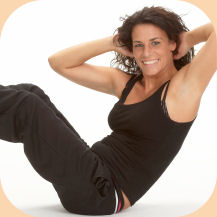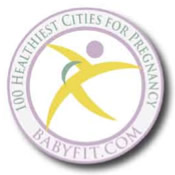 Sit upright in your chair in a comfortable position. Place one or both palms on your abdomen. Now cough a few times. You should have felt your abdominal muscles tighten. Now, keeping your hands there, take a deep inhale through the nose. On your exhale, open your lips slightly and push all of that air out of your mouth as forcefully and slowly as possible, making your exhale audible (like a "whoooooo" or "seeeeeeee" sound). You should have felt the same muscles tighten as when you coughed. These are your deep, transverse abdominis muscle, which act as your body's corset. When these muscles strengthen, your belly pulls in tighter and flatter. The deep, audible breathing that people do during Pilates (which you just tried a moment ago) helps hone in on the transverse abs in a way that no other exercise can. Pilates focuses on these deep muscles in each and every move you make, which is just one reason why they are so effective at strengthening the core.
Sit upright in your chair in a comfortable position. Place one or both palms on your abdomen. Now cough a few times. You should have felt your abdominal muscles tighten. Now, keeping your hands there, take a deep inhale through the nose. On your exhale, open your lips slightly and push all of that air out of your mouth as forcefully and slowly as possible, making your exhale audible (like a "whoooooo" or "seeeeeeee" sound). You should have felt the same muscles tighten as when you coughed. These are your deep, transverse abdominis muscle, which act as your body's corset. When these muscles strengthen, your belly pulls in tighter and flatter. The deep, audible breathing that people do during Pilates (which you just tried a moment ago) helps hone in on the transverse abs in a way that no other exercise can. Pilates focuses on these deep muscles in each and every move you make, which is just one reason why they are so effective at strengthening the core. When done correctly and with proper focus, Pilates is not easy-no matter how fit you are. If you tried Pilates once or twice but weren't impressed, you probably weren't doing it correctly. And that's not your fault if your instructor (in class or on video) didn't explain it properly. When performing every single Pilates exercise you should also: 1. Breathe correctly. Joseph Pilates used to say, "Even if you follow no other instructions, learn to breathe correctly." Use deep breathing (described above) to target and tone your deep transverse abs. Your inhale should expand the ribcage (diaphragm) but not the belly, which should be tight and flat as if you are wearing a corset. This helps you keep your core muscles engaged. 2. Concentrate on pulling your shoulders away from your ears and retracting your shoulder blades toward the center of your spine. 3. Properly align the spine. Your head and neck should follow the natural line of your spine at all times. 4. Focus on every movement as if it comes from the center of the body (your core). 5. Practice control. Don't use momentum to help you move. Movements should be done in a slow and controlled manner at all times. 6. Keep your body grounded and stable. If you're really focusing on the core, your body should be square on the mat and you should not rock or slide in any direction during exercises that involve lying, sitting, or kneeling. (This is one of the most common mistakes I see as an instructor.) Continued › |






Member Comments